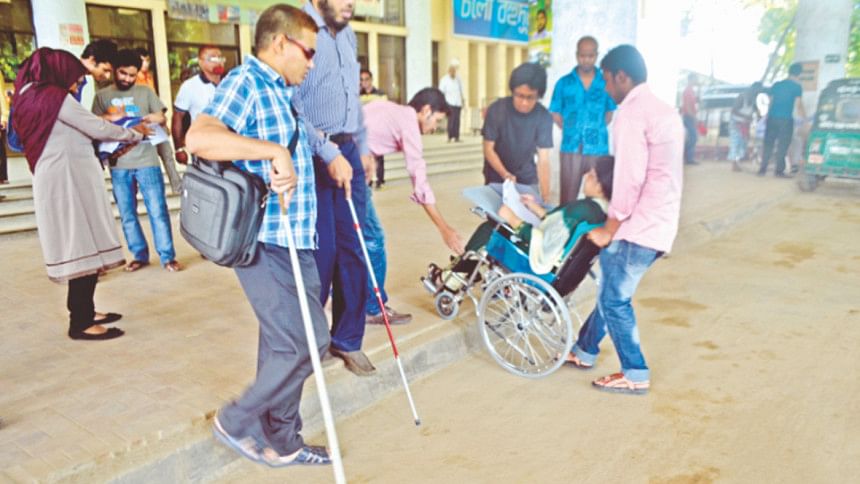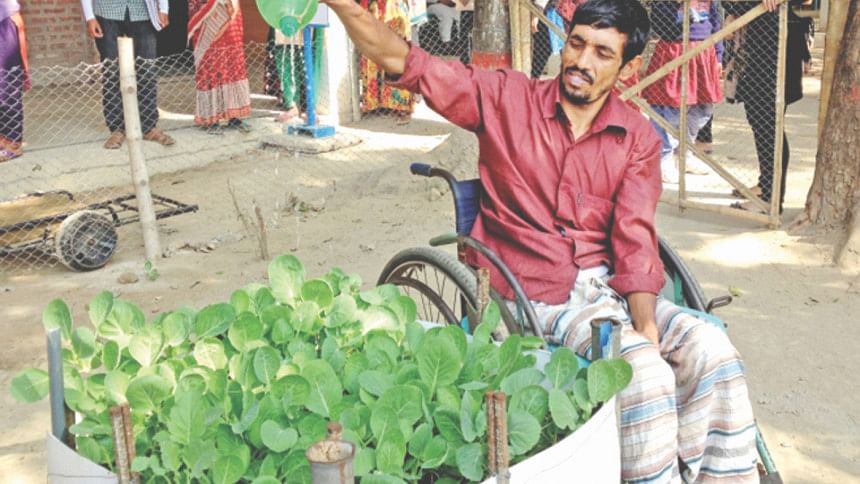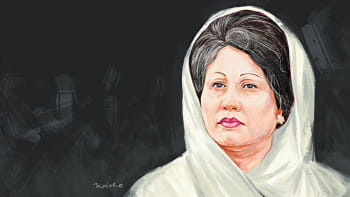Unfriendly Dhaka for the forgotten 10 percent

The population of Dhaka is growing by a little over four percent per year and stands in its wider metropolitan area at an estimated 15 million in 2015, giving the impression that the city is congenial for human habitation, that the city provides employment to all those who throng to it, that there are education, health and housing facilities here that draw people, that there is a public transport system that works for the young and the old, that the social requirements of the citizenry is aptly addressed, and that the city provides safety and security to all who embrace it.
While the argument in favour of congeniality, employment and essential facilities, albeit limited, has to hold water, or else the population acceleration would have abated, but the capital city lacks greatly in terms of urban conveyance, community recreation, and safety and security.
From the beast-of-burden carriages of the first capital Jahangir Nagar in 1610 to today's rickshaws, buses, trains (we even tried in vain circumnavigating motor vessels), the city has simply been unable to cope with the ever-burgeoning demand. But, people have come to live with it, grudgingly all the way. With numerous under-construction flyovers and the possibility of launching the Mass Rapid Transit (MRT) system by 2019-20, the situation looks promising.

As for entertainment, people have discovered options in taking joyfully to the street and on to the few open areas on the great days that we have – Pohela Boishakh, Ekushey February, Independence Day and Victory Day. Some recent innovations have also eased the pressure on the amusement front; Valentine's Day, Mother's Day, Teacher's Day etc. as well as the social networks on the internet.
Despite the positives that one may extract from the mentioned considerations, our capital city, the tenth largest city in the world (in terms of population), has most deplorably failed to be a friendly abode for the physically challenged, those who find it difficult to do things that other people can do easily. This expression includes but is not limited to disability from any physical, mental, visual, and aural impairment. By Bangladesh Bureau of Statistics estimation almost a tenth of the population is suffering from disabilities; almost 16 percent according to the World Bank and WHO.
The street, the public transportation service, toilets, public places and buildings are no-go areas for people who cannot move without aid or wheelchair, lack power of vision, or cannot access a service because of their physical or mental limitations. They are the victims of our ignorance, whereas society is incomplete without them.
Most roads do not have pedestrian pavement or they are not user-friendly for the disabled. Other roads are too crowded with all sorts of fast-moving traffic. Have we not seen the blind desperate for some direction? Roadsides have deep uncovered drains. The way the pavements are laid out it is impossible for any wheelchair-bound person to travel along it.
Except for a handful of buildings, there is no ramp for wheelchairs to reach the plinth level to access any mechanical means of vertical transport.
Accessibility has been made mandatory under clause 64 of the Dhaka Metropolis Building Construction Rules, 2008: “Universal accessibility from the parking space to the lift lobby (if any) must exist in all buildings.” The law further stipulates, “In all buildings suitable for public use with more than 100 sqm floor area (such as: hotel, educational institution, institutional, health service, assembly and commercial use), accessibility for the disabled and all others must essentially be ensured”. On scrutiny, it will appear that violation of the law is the norm.
Often enough stairs do not have rails which would aid especially the blind. According to Annexure 1 of the 2008 Rules, fire stairs must have handrails on one or more of its sides, also along the middle, depending on the width.
Without, therefore, the help of some kind person in the vicinity, the blind and the elderly would be unable to climb stairs to access a building.
Let us imagine a wheelchair-bound person having reached a doorway of an office or a shopping mall, but has no way of getting in without help because the door cannot be pushed ajar. Doors therefore need to be always manned by a doorkeeper or automated for the disabled. This is not always the case.

Lift cabins should be at least 1.5x1.5m so as to allow a wheelchair to turn. Many of our public lifts are narrower. The operating buttons, braille punched for the blind, should be located within reach of a person sitting on a wheelchair. The building levels/floors have to be announced on a PA system so that the blind may know that the desired floor has arrived.
Toilets have to be custom-designed for the disabled. The Rules state that every floor must have one toilet or 5 percent of all toilets (whichever is more) for the disabled, but this provision is violated wholesale in government offices, public places, shopping centres, railway stations, airports, large hotels and restaurants, schools, colleges and universities. Until such time it is not practical to provide a dedicated toilet in an existing building, let at least one of the general toilets be large enough for use of the physically handicapped.
As for car parking for the disabled there is total lack of consideration, although the Rules require at least one parking or 5 percent of the total number of necessary parking (whichever is more) to be reserved for the disabled. The width of such parking will have to be wider than that for others at minimum 3.2m. Has anyone seen any such car parking anywhere in Dhaka?
The wheelchair-bound are also denied access into our parks; they can only observe the scenery from the outside. Some parks in the city, for instance Dhanmandi Lake, have been provided with toilets, but none for those on wheelchairs, whereas a simple ramp and a wider door would have sufficed.
The challenged have no chance at stadiums, cinema halls and auditoriums, or at Rabindra Sarobar. Most of these venues have split levels with steps, and no ramp or elevator. The Rules though are in their favour, specifying suitable seating at assembly halls reserved for the disabled beside a 1200mm-wide aisle. To preclude discretion, the Rules ordain that the reserved seats be in the same row and be located on the same floor as other seats. Is anyone listening?
For seeking service, such as shopping, ticketing, banking and postal, the disabled in this city cannot access the counters. They are too high. All that is needed is a low counter that also be used by others.
In conjunction with the Rules for the disabled, minimal and incomplete though they maybe, the awareness and the effort from the 90 percent others is simply not there. They have been marginalised, knowingly or out of ignorance. In short, Dhaka, like possibly many other cities across the world, has condemned the physically challenged for the worse. This has to change. Life must be converted to their advantage.
The writer is Managing Director & CEO, GERAMfERA and Former Professor, Department of Architecture, Bangladesh University of Engineering & Technology.

 For all latest news, follow The Daily Star's Google News channel.
For all latest news, follow The Daily Star's Google News channel. 



Comments